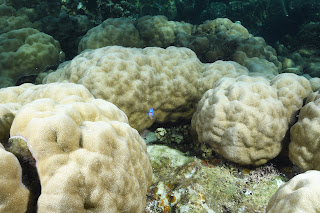Porites
Most people who come to Palau are traveling for one reason: coral. The reefs in this small island nation are comparatively healthy and great for diving. In my case, the specific coral that brings me to Palau is called Porites lobata. If you’re not interested in the Latin name, you can call it “lobe coral” or “yellow mounding coral.”
 |
| Porites lobata. Photo by Kharis Schrage. |
In Palau, Porites
is even more heat-tolerant than elsewhere. There are semi-enclosed lagoons in
the southern part of the Palauan archipelago that get warmer than anywhere
else. There’s not a lot of water flowing in and out of the lagoons, so they
tend to heat up. Porites that live in
the lagoons
are exposed to warmer and more variable temperatures on a daily basis, so when
an El Niño comes along and heats up the equatorial Pacific, they’re relatively
unperturbed.
Scientists wondered for a long time how the corals in the lagoons
could survive so well. A few years ago, a PhD student at WHOI named Hanny
Rivera dug into this question and found that the heat-tolerant corals were
genetically different from corals that were more susceptible to bleaching.
Corals in the lagoons are actually adapting to the heat.
Some of you might remember Hanny. She and I worked together
closely on a sampling trip to Palau in 2018. Together, we came up with the idea
to take the research one step farther. What if heat-tolerant corals from the
lagoons could send their larvae to the outer reefs? What if those heat-tolerant
larvae could settle and grow on the outer reefs? What if they could make the
outer reefs more resilient to bleaching?
 |
| One of the corals we sampled and tagged. Photo by Kharis Schrage. |
My grad student and I have been tagging and sampling Porites corals at different sites, both inside and outside of lagoons. Our goal this trip is to get as much background information on the tagged adults as we can – what genetic lineage they belong to and whether they’re male or female. That way, when my team comes back next year, we can collect exactly the corals that we want to spawn for our experiment. This is the reconnaissance mission; next year is the big operation.
Long live Porites lobata!
Comments
Post a Comment